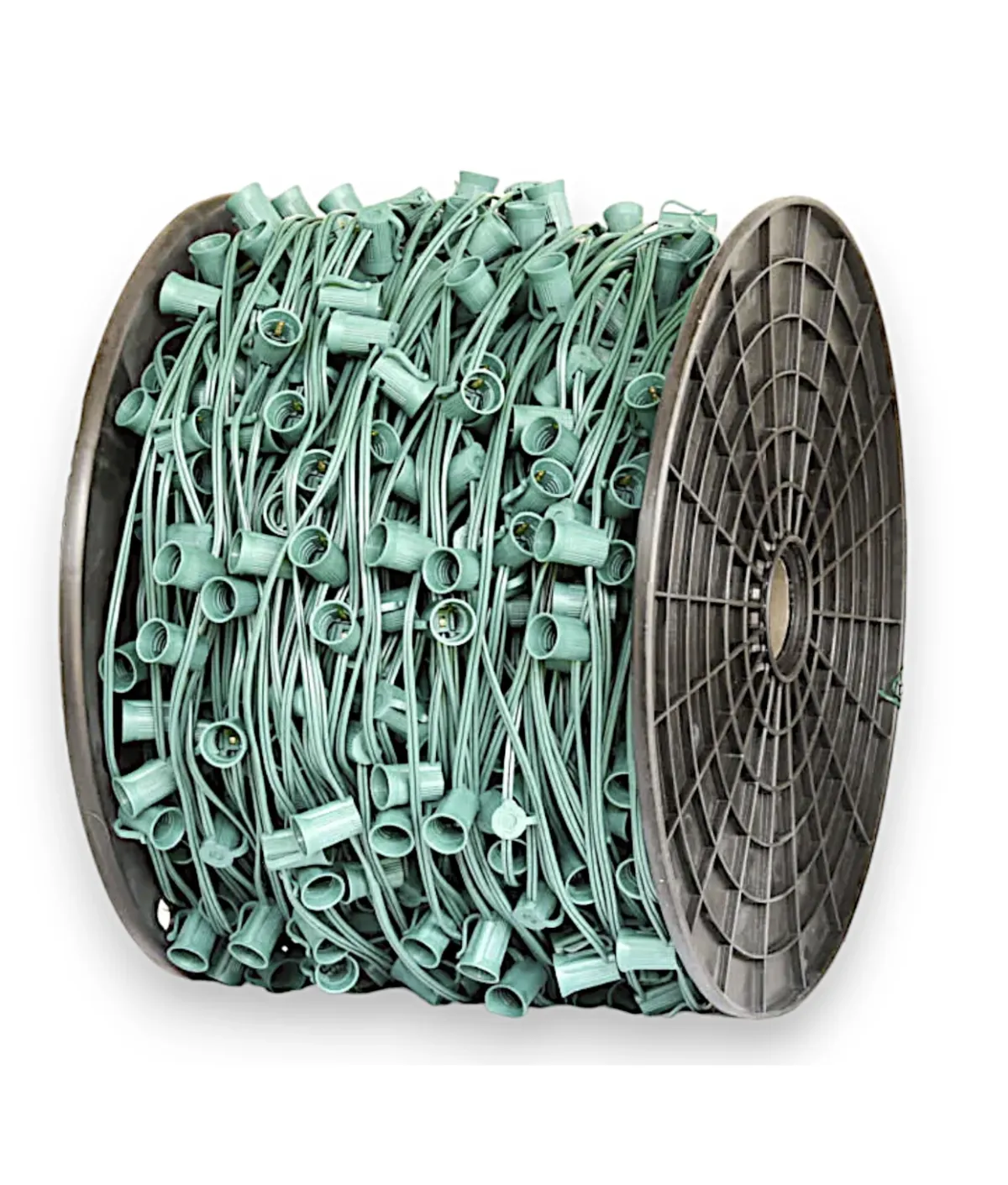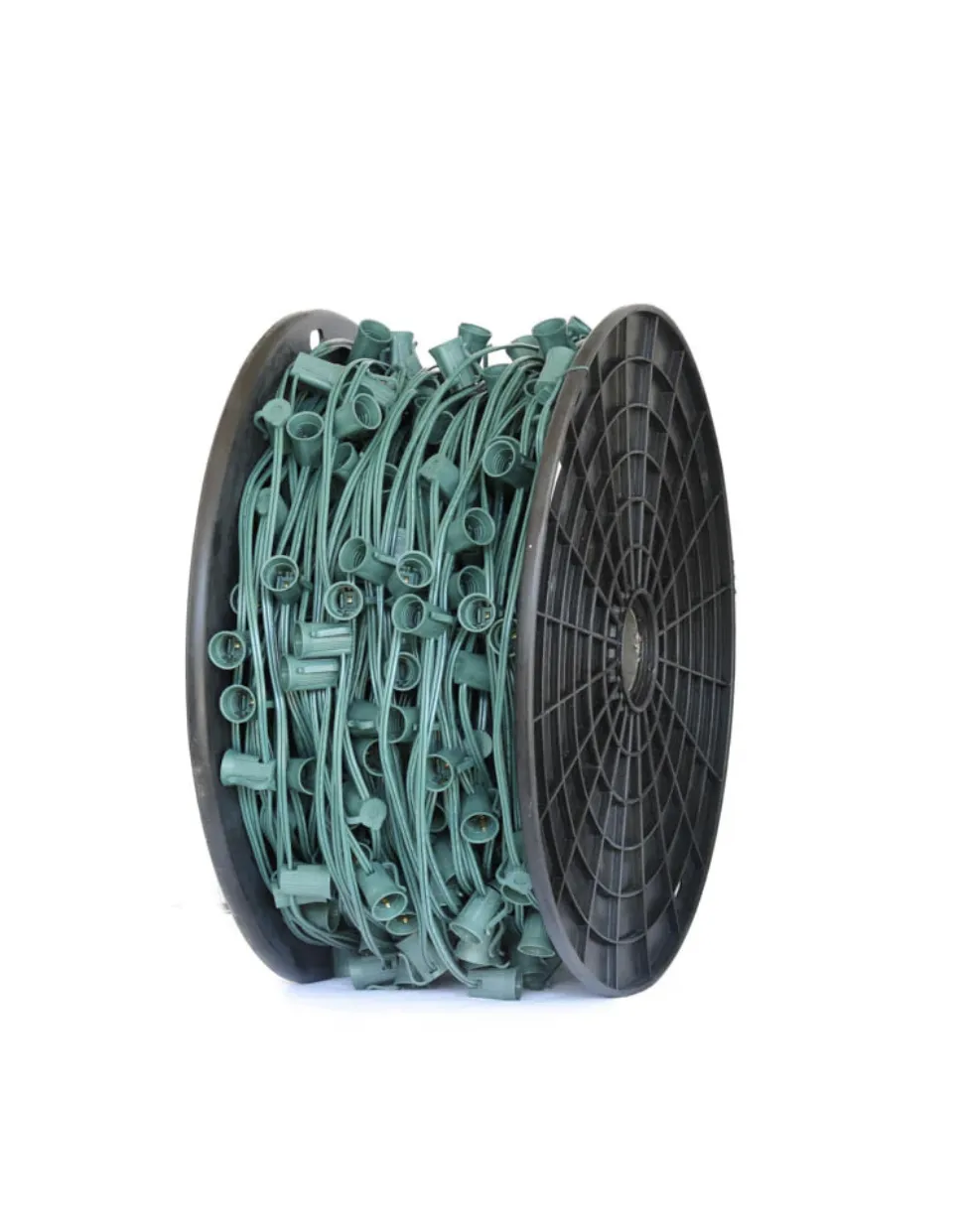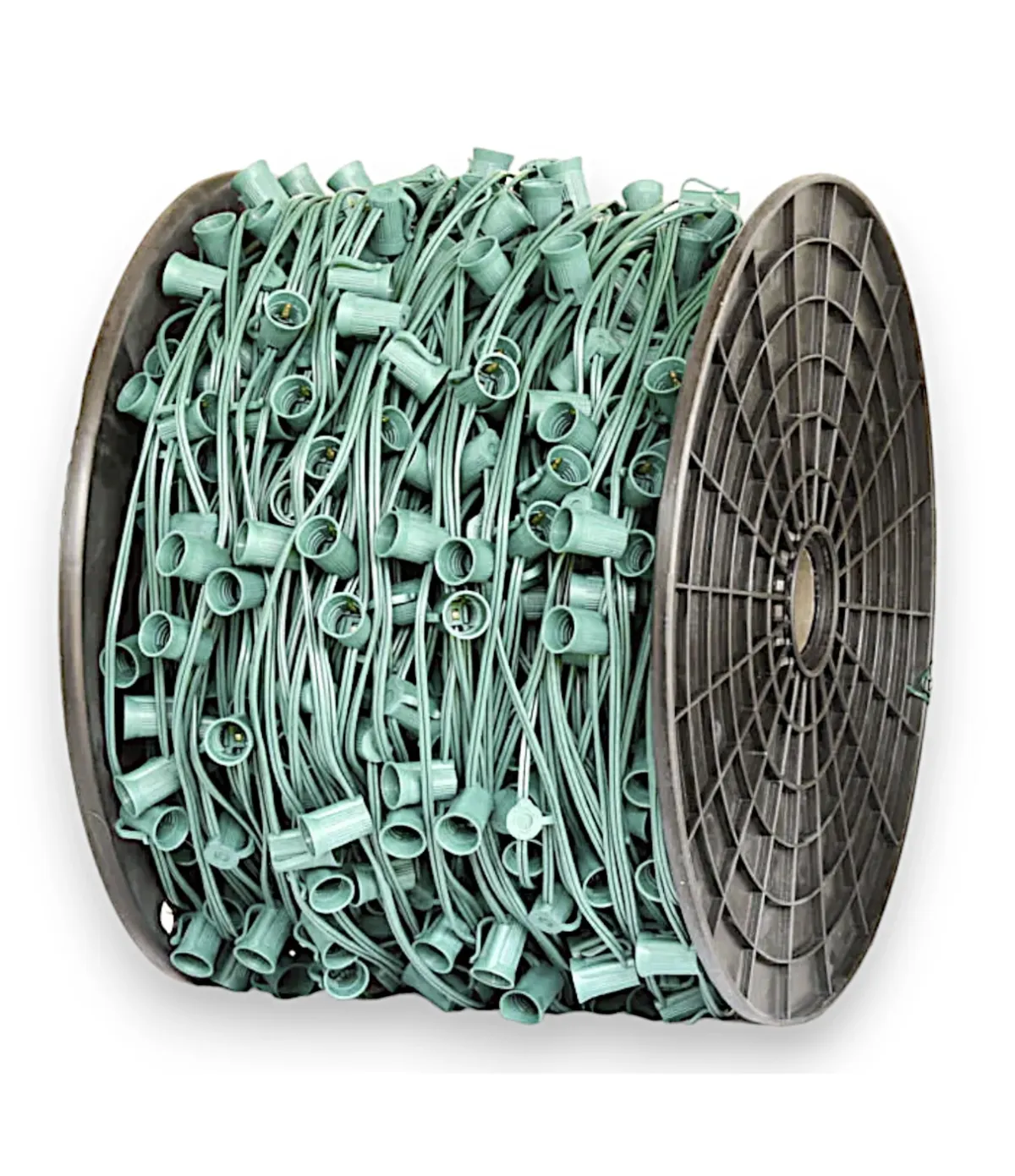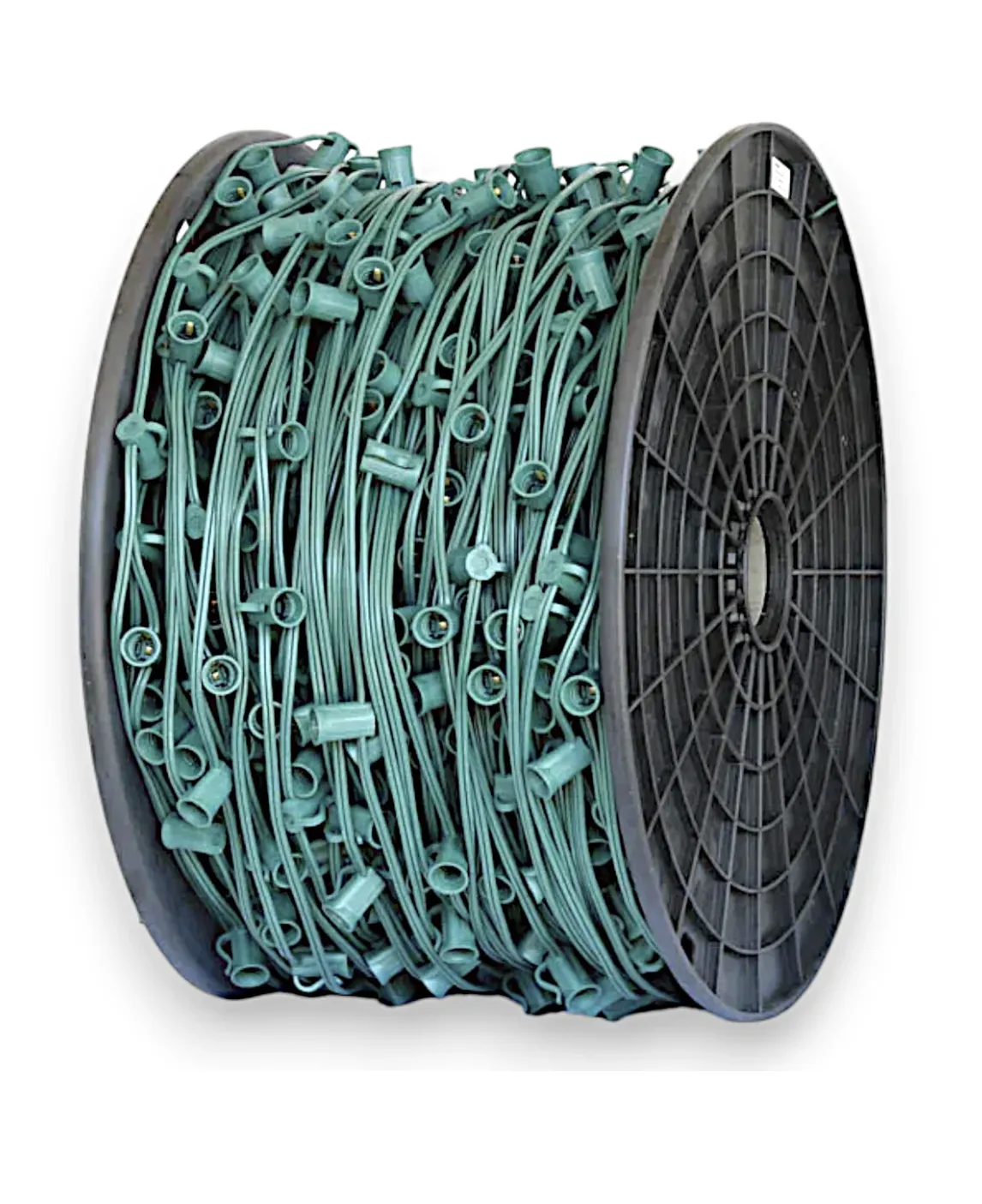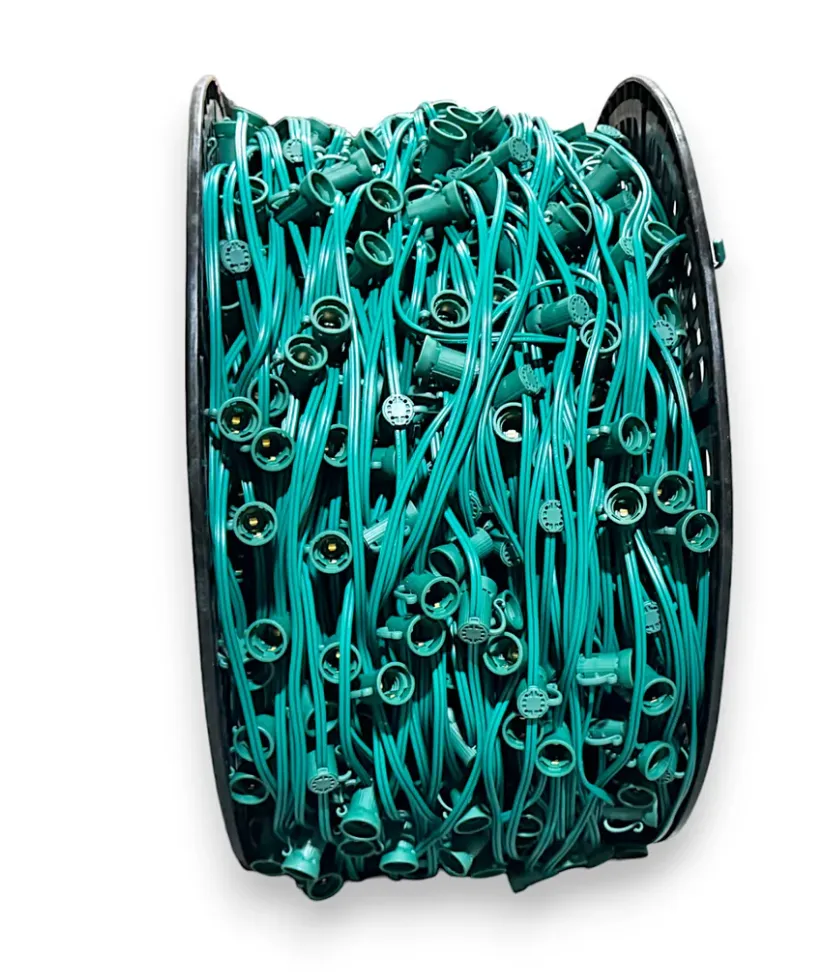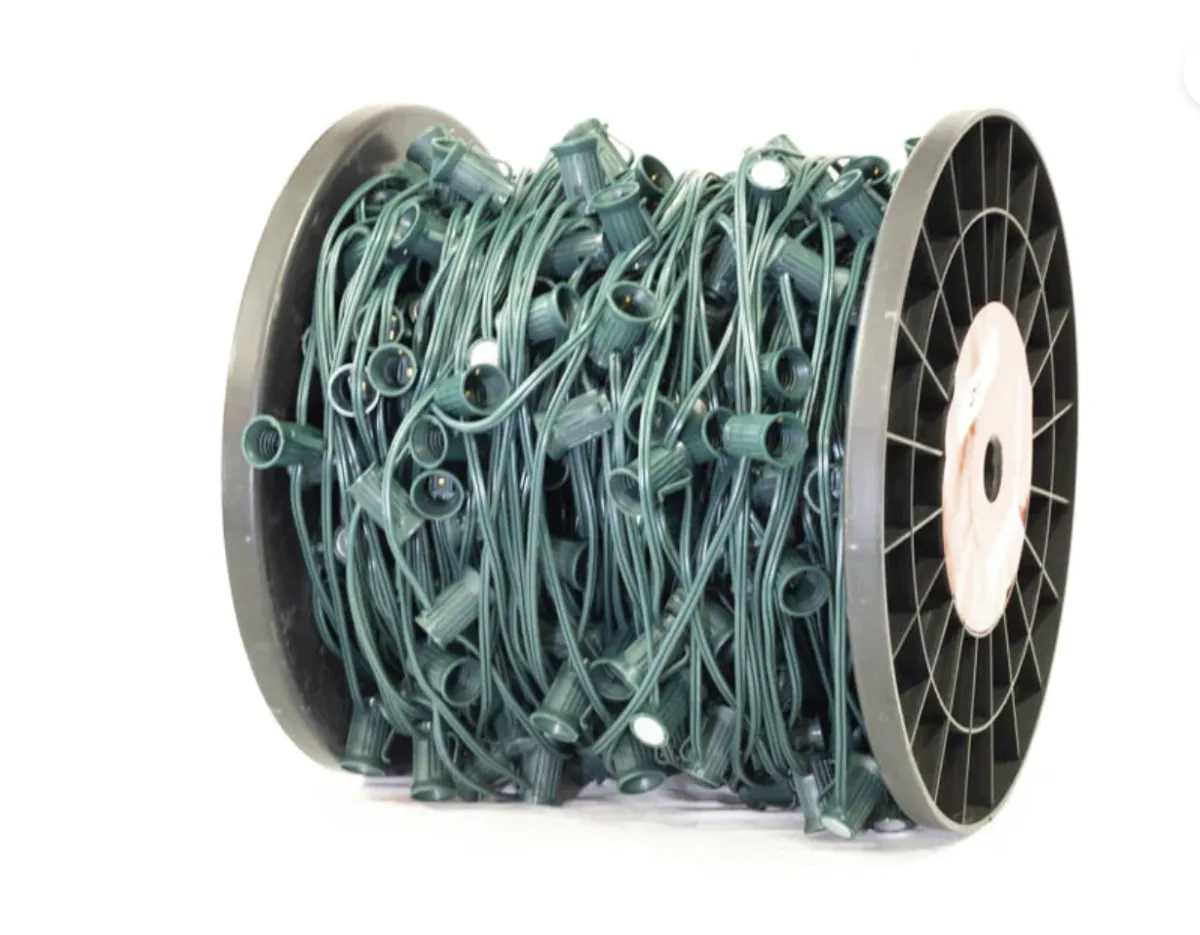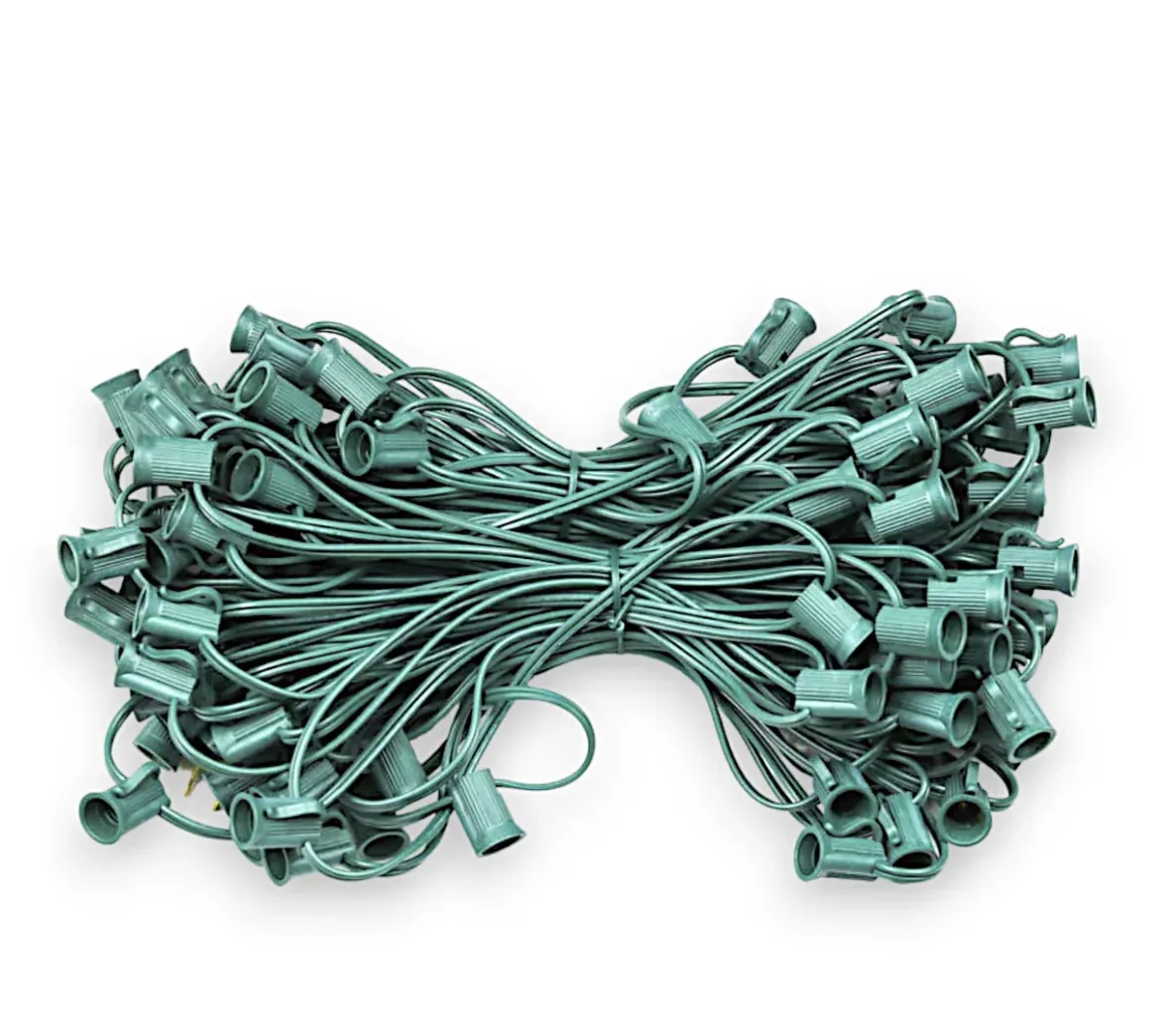C9 & C7 Socket Spools & Stringers
Discover our premium collection of socket wire spools and stringers, the essential foundation for creating stunning light displays. Designed for both professional installers and ambitious homeowners, our range includes bulk C7 and C9 socket wire spools with flexible spacing options, pre-made light stringers for quick setups, and convenient accessories like spool holders. These versatile, durable components are perfect for residential rooflines, enchanting tree displays, and large-scale commercial projects. Suitable for indoor and outdoor use, and compatible with both incandescent and LED bulbs, our professional-grade products offer the quality and flexibility needed to bring your creative lighting visions to life. Explore our selection and elevate your illumination projects with unmatched versatility and reliability.
Socket Spools
C9 1000' Socket Spool
Our C9 1000' Bulk Spool of Socket Wire, available in green or white, offers professional-grade flexibility for custom lighting projects. With spacing options from 6" to 48", it's ideal for both residential rooflines (12-15" spacing) and tree installations (24-48" spacing). The durable SPT-1 wire withstands outdoor conditions and is compatible with both incandescent and LED C9 bulbs. This customizable spool allows for precise length cutting, minimizing waste and maximizing efficiency for high-quality, adaptable lighting displays.
C9 500' Socket Spool
Our C9 500' Bulk Spool of Green Wire, available with 12" (500 sockets) or 15" (400 sockets) spacing, is perfect for professional-grade Christmas lighting installations. Featuring commercial-quality SPT-1, 8-amp wire and durable E17 sockets, this customizable spool is ideal for large-scale outdoor projects. Easily cut to desired lengths and pair with snap-on plugs (sold separately) for tailored lighting solutions in both residential and commercial settings. The 12" spacing offers vibrant, balanced lighting, while the 15" option provides a classic look with fewer bulbs per run.
C9 1000' 12"&15" Socket Wire Spool (SPT-2)
Our C9 1000' Socket Wire Spool (SPT-2) offers professional-grade flexibility with dual 12" and 15" spacing options. This customizable spool features heavy-duty SPT-2 wire for enhanced durability in all weather conditions. The 12" spacing is perfect for dense, vibrant displays on rooflines and pathways, while the 15" option provides a classic look with fewer bulbs per run. Compatible with both incandescent and LED C9 bulbs, this 1000' spool allows for precise cutting to fit any residential or commercial lighting project, ensuring efficient and long-lasting installations.
C7 1000' Green Wire Socket Spool (SPT-2)
Our 1000' bulk spool of green SPT-2 wire features 15" spacing with 1000 C7 sockets, ideal for commercial and residential outdoor displays. This 8-amp (960-watt) commercial-grade wire with Admiral Brand sockets allows for custom-length installations using snap-on plugs (sold separately). Suitable for indoor/outdoor use, it accommodates up to 160 sockets with 5-watt incandescent bulbs or 384 sockets with 1-watt LED bulbs per run. This versatile, durable C7 light line is perfect for creating professional-quality lighting displays in various settings.
C7 1000' Socket Spool
Our C7 1000' Bulk Spool of Socket Wire offers professional-grade flexibility for custom lighting projects. Available in green or white, with spacing options from 12" to 36", it's ideal for both residential rooflines (12-15" spacing) and tree installations (24-36" spacing). The durable SPT-1 wire withstands outdoor conditions and is compatible with both incandescent and LED C7 bulbs. This customizable spool allows for precise length cutting, minimizing waste and maximizing efficiency for high-quality, adaptable lighting displays in various settings.
C9/C7 500' Magnetic Spool
The Fastest Way to Install Holiday Lights on Metal Surfaces. Save time and effort this holiday season with Magnetic Spools. Designed for quick and easy installation, these magnetic spools are perfect for decorating your home or office building. The magnetic sockets eliminate the need for traditional mounting clips, making your installations faster and more efficient. Whether you’re lining rooflines, gutters, or fences, these spools are ideal for any surface where ferrous metal is present.
Available in 500' & 250', 12" or 15" Spacing.
Socket Wire Stringers
C9 12" Spacing Socket Wire Stringers
Our 25', 50' or 100' Holiday Light String features professional-grade, UV-protected 18-gauge wire with sockets spaced 12" apart. Designed for both indoor and outdoor use, these UL-recognized strings offer 5 Amp capacity SPT-1 insulation and durable sockets with weep holes for all-weather performance. Compatible with E12 Candelabra base bulbs (C7, C9, G30; sold separately), these versatile strings allow end-to-end connectivity for extended displays. Perfect for holiday decorations, event lighting, and year-round use in residential and commercial settings. Available in Green, White, Brown and Black.
C7 12" Spacing Socket Wire Stringers
Our professional-grade 25', 50' or 100' light string features sockets spaced 12" apart, perfect for commercial and residential decorators. Designed for both indoor and outdoor use, it's compatible with incandescent or LED C7, G30, and G40 bulbs (sold separately). The SPT-1 insulated wire offers 5 Amp capacity and includes weep-hole sockets for all-weather performance. With male and female plugs for end-to-end connections, these UL-recognized strings can handle up to 480 watts per run. Ideal for holiday displays, patio lighting, and year-round events, these durable strings ensure long-lasting, brilliant illumination for any occasion. Available in Green, White, Brown and Black.
Frequently Asked Questions
What's the difference between socket wire spools and stringers?
cket wire spools are bulk reels of wire with sockets at regular intervals, allowing for custom-length cuts. Stringers are pre-cut lengths of socket wire, typically with plugs attached, ready for immediate use.
Can I use the same socket wire for both C7 and C9 bulbs?
No, C7 and C9 bulbs require different socket sizes. Always check the product specifications to ensure you're using the correct socket wire for your chosen bulb type.
How do I determine the right spacing for my project?
Common spacings are 12", 15", and 24". Use closer spacing (12"-15") for dense, vibrant displays on rooflines or fences. Wider spacing (24" or more) works well for tree wrapping or creating a more subtle effect.
Are these socket wires suitable for outdoor use?
Most of our socket wires are rated for both indoor and outdoor use. Look for products labeled as "weatherproof" or "outdoor-rated" for the best durability in external conditions.
How many bulbs can I safely connect on a single run?
This depends on the wire's amperage rating and the wattage of your bulbs. For example, on an 8-amp wire, you can typically run up to 160 sockets with 5-watt incandescent bulbs or 384 sockets with 1-watt LED bulbs. Always check the product specifications and local electrical codes for safe operation.
Discover Expert Tips on Our Blog

Stay Safe on Steep Roofs: Essential Equipment and Footwear
As professional Christmas light installers, our work brings joy and beauty to homes during the holiday season. However, it's crucial to remember that our job involves significant risks, particularly when working at heights. This comprehensive guide will explore essential safety practices, tools, and strategies to ensure you and your team stay safe while delivering exceptional service.
The Importance of Safety in Christmas Light Installation
Safety should always be your top priority in the Christmas light installation business. No matter how much money you make or how efficient you become, all of that means nothing if you or a team member gets injured on the job. Falls from roofs can result in severe injuries or worse, and they can happen in the blink of an eye.
Remember, you're not just responsible for your own safety, but also for the safety of your team members. By implementing and consistently following proper safety protocols, you protect your health, your business, and your employees.
Common Hazards in Christmas Light Installation
Before we dive into safety practices, let's review some common hazards you might encounter:
1. Slippery surfaces: Roofs can be slick due to morning frost, rain, or moss growth.
2. Steep pitches: The steepness of a roof can make it challenging to maintain balance.
3. Weather changes: Conditions can change rapidly, making a previously safe situation dangerous.
4. Electrical hazards: Working with electrical equipment outdoors always carries risks.
5. Ladder accidents: Improper ladder use is a common cause of injuries.
6. Fatigue: Long hours during the busy season can lead to decreased alertness.
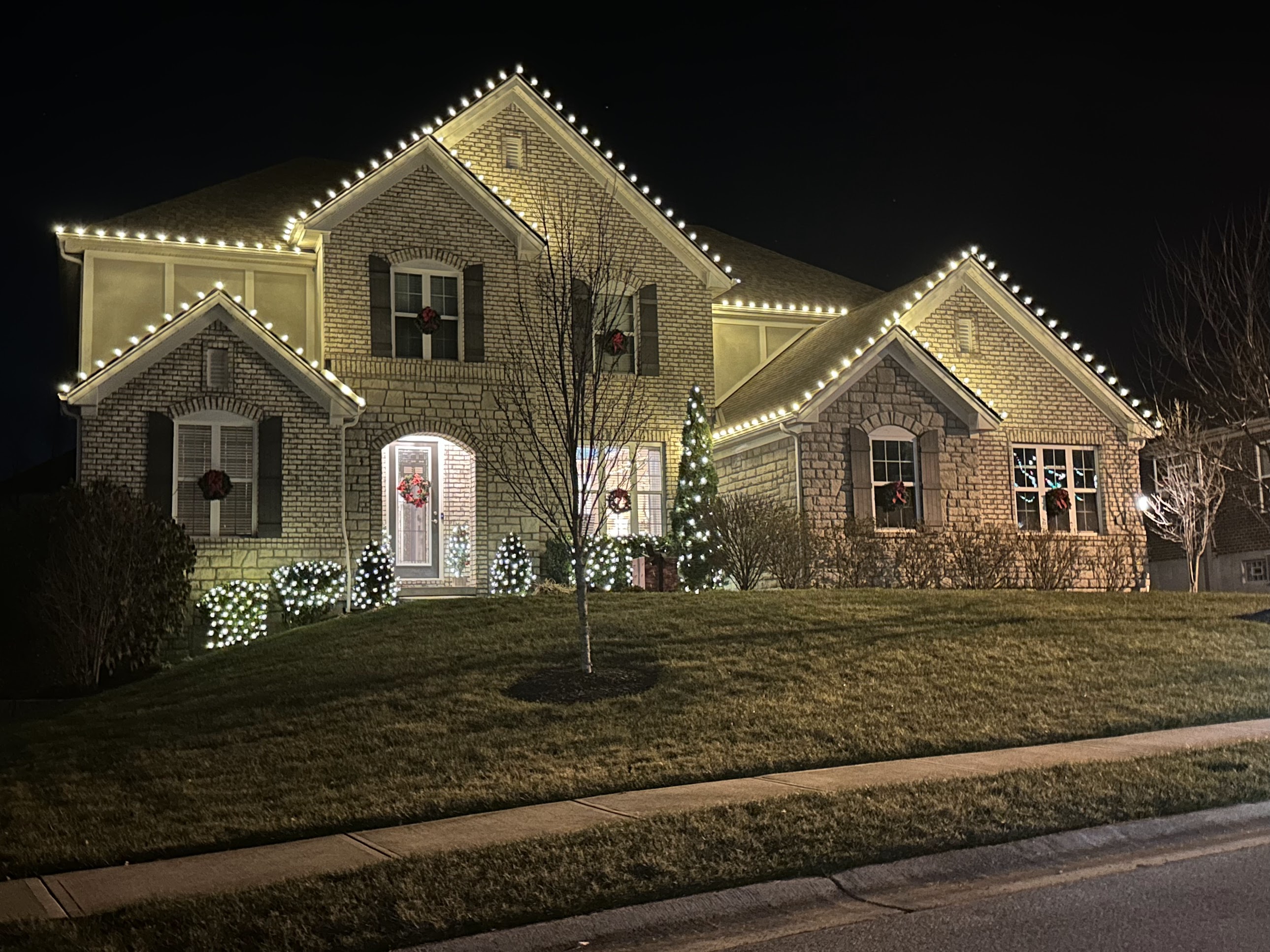
Essential Safety Equipment
Having the right safety equipment is crucial. Here are some must-have items:
Safety Harness
A properly fitted safety harness is your most important piece of safety equipment. It should be worn whenever you're working at heights. Make sure to inspect your harness before each use and replace it if you notice any wear or damage.
Roof Anchors
Roof anchors provide a secure point to attach your safety harness. The Ridge Pro is a popular option, but remember that it's only OSHA approved as an anchor when properly bolted to the roof.
Proper Footwear
Good footwear is essential for maintaining grip on various roof surfaces. Consider these options:
1. Cougar Paws: Designed specifically for roof work, these shoes provide excellent traction.
2. Fila Memory Foam Work Shoes: Some installers find these provide even better grip than Cougar Paws.
3. Hey Dude shoes: Another option worth testing for roof work.
Ladder Stabilizers
Ladder stabilizers help prevent your ladder from slipping or falling. They're especially important when working on uneven ground or approaching gutters.
Specialized Tools for Safe Installation
Several specialized tools can help make your work safer and more efficient:
The Goat
The Goat is a popular tool that hooks over the roof peak, providing a stable point to hold onto while working. While not OSHA approved as a safety device on its own, it can significantly improve your stability and confidence on the roof.
Pitch Hoppers
Pitch Hoppers are another useful tool for working on steep roofs. They provide a stable platform to kneel or stand on. Remember, when using a Pitch Hopper, either have all your weight on it or none at all. Putting only part of your weight on it can cause it to slip.
Rope Systems
For very high or challenging roofs, a rope system can provide an extra layer of safety. This involves running a rope over the peak of the house and securing it to a sturdy anchor point (like a large tree) on the opposite side. However, only use this method if you're trained in proper knot tying and rope safety techniques.

Safe Work Practices
Having the right equipment is only part of the equation. Safe work practices are equally important:
Assess the Roof Before Starting
Before you start any job, take the time to carefully assess the roof. Look for:
1. Signs of wear or damage on shingles
2. The pitch of the roof
3. Potential slip hazards like moss or frost
4. Stable areas for placing your ladder
Plan Your Movements
Don't start working until you have a clear plan. Know where you'll move, where you'll place your tools, and how you'll access different areas of the roof. Having a plan reduces the likelihood of making risky moves on the fly.
Use the Right Ladder Technique
When using a ladder:
1. Ensure it's on stable, level ground
2. Maintain three points of contact at all times
3. Don't overreach - move the ladder instead
4. Use ladder stabilizers for extra security
Always Use Fall Protection
Even if you feel comfortable on a roof, always use proper fall protection. This typically means wearing a safety harness attached to a secure anchor point.
Be Weather Aware
Check the weather forecast before starting work and be prepared to reschedule if conditions are unsafe. Be especially cautious of:
1. Rain or snow, which can make surfaces slippery
2. High winds, which can affect your balance and make ladder use dangerous
3. Extreme temperatures, which can affect your physical performance
Take Regular Breaks
Fatigue can significantly increase your risk of accidents. Take regular breaks, stay hydrated, and don't push yourself beyond your limits, especially during busy periods.

Training Your Team
If you have a team, proper training is crucial:
1. Provide comprehensive safety training before allowing anyone to work on roofs
2. Regularly review and update safety procedures
3. Encourage team members to speak up about safety concerns
4. Lead by example - always follow safety procedures yourself
Consider creating a safety checklist that team members must complete before starting each job. This can help ensure that no important safety steps are missed.
Emergency Preparedness
Despite our best efforts, accidents can still happen. Be prepared:
1. Always have a fully stocked first aid kit easily accessible
2. Ensure all team members know basic first aid
3. Have an emergency plan for what to do if someone falls
4. Keep emergency contact numbers readily available
Remember, if someone falls while wearing a harness, they need to be rescued quickly to avoid suspension trauma. Have a plan for how you would safely get someone down in this situation.
Leveraging Technology for Safety
Modern technology can help enhance your safety practices:
Safety Apps
Consider using safety-focused apps that can help you track and manage safety procedures. Some apps can even send automatic alerts if a worker falls or remains motionless for too long.
Weather Apps
Use reliable weather apps to stay informed about changing conditions that could affect your work safety.
Project Management Software
While not directly safety-related, good project management software can help you avoid overbooking, which can lead to rushed work and increased risk.
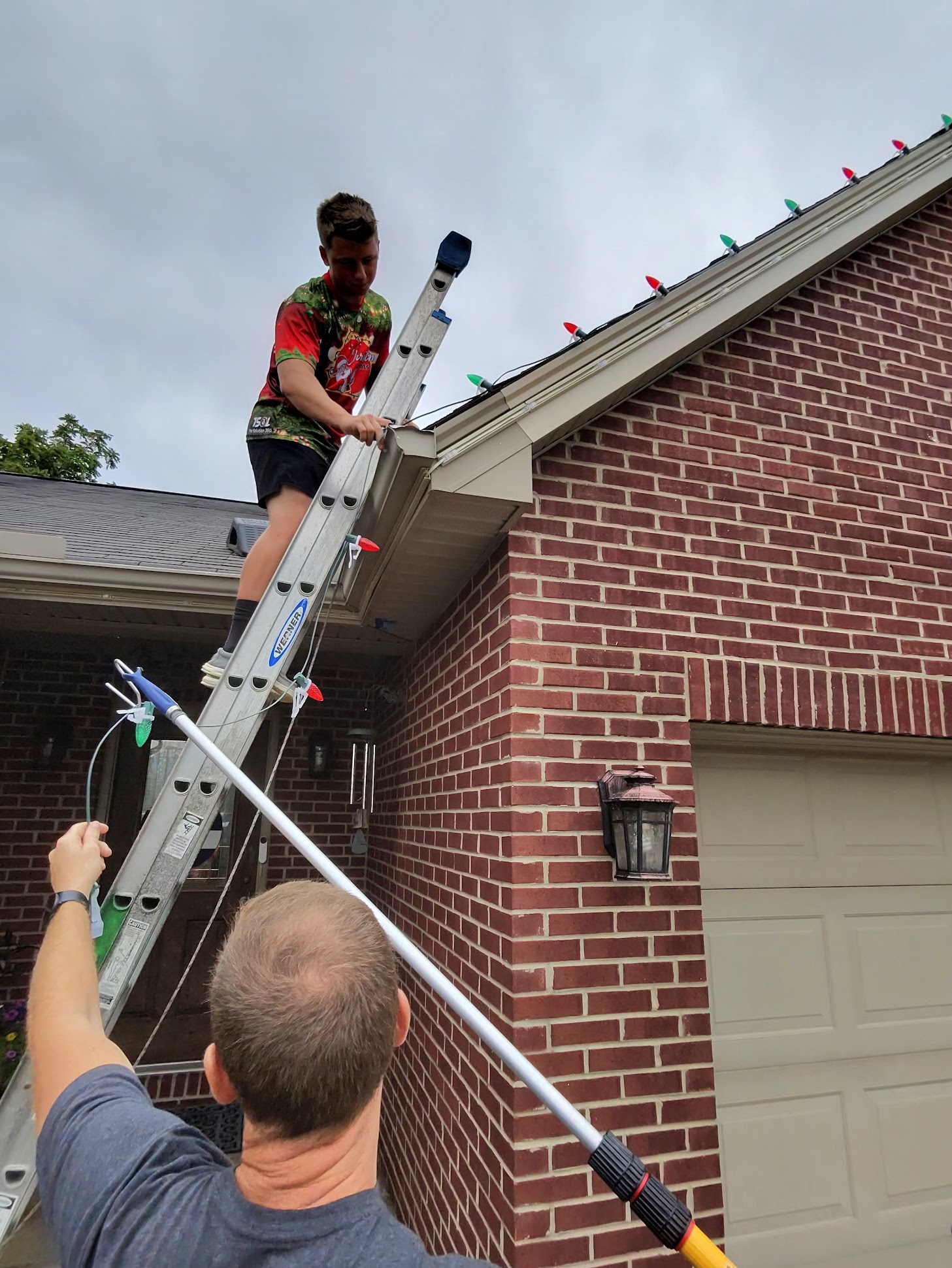
The Business Case for Safety
Prioritizing safety isn't just about avoiding accidents - it's good business:
1. It reduces the risk of costly injuries and workers' compensation claims
2. It can lower your insurance premiums
3. It enhances your reputation as a professional, responsible business
4. It improves employee morale and retention
Remember, one serious accident can potentially bankrupt your business. The time and money invested in safety measures are always well spent.
Continuous Improvement in Safety
Safety isn't a one-time achievement - it's an ongoing process:
1. Regularly review and update your safety procedures
2. Stay informed about new safety equipment and best practices
3. Encourage feedback from your team about safety concerns
4. Conduct "near miss" analyses to learn from close calls
Consider joining professional associations related to holiday lighting or exterior services. These can be great sources of up-to-date safety information.
In the Christmas light installation business, safety should always be your top priority. By using the right equipment, following safe work practices, properly training your team, and staying prepared for emergencies, you can significantly reduce the risks associated with our work.
Remember, no job is worth risking your health or life. If a situation feels unsafe, it probably is. Don't be afraid to turn down jobs that you can't complete safely, and never cut corners on safety to save time or money.
By prioritizing safety, you protect yourself, your team, and your business. You also demonstrate professionalism and care to your clients, which can lead to better reviews, more referrals, and long-term success in the Christmas light installation industry.
Stay safe out there, and may your holiday season be merry, bright, and incident-free!
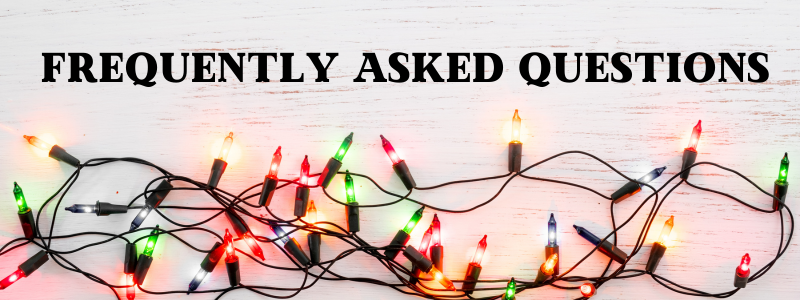
1. Q: What is the most important piece of safety equipment for Christmas light installation?
A: The most important piece of safety equipment is a properly fitted safety harness. It should be worn whenever working at heights and inspected before each use. Replace it immediately if you notice any wear or damage.
2. Q: Are tools like The Goat and Pitch Hoppers OSHA-approved safety devices?
A: No, tools like The Goat and Pitch Hoppers are not OSHA-approved safety devices on their own. While they can significantly improve stability and confidence on the roof, they should be used in conjunction with proper fall protection equipment like a safety harness and anchor point.
3. Q: What type of footwear is best for roof work during Christmas light installation?
A: Good options for roof work include Cougar Paws (designed specifically for roof work), Fila Memory Foam Work Shoes (which some installers find provide even better grip), and Hey Dude shoes. The key is to choose footwear that provides excellent traction on various roof surfaces.
4. Q: How often should I inspect my safety equipment?
A: You should inspect all your safety equipment, including harnesses, ropes, and anchors, before each use. Look for signs of wear, damage, or degradation. If you notice any issues, replace the equipment immediately.
5. Q: What should I do if the weather changes suddenly while I'm on a job?
A: If weather conditions change suddenly and become unsafe (e.g., rain, high winds, or extreme temperatures), it's best to stop work immediately and safely descend from the roof. Safety should always be prioritized over completing a job.
6. Q: How can I ensure my team follows proper safety procedures?
A: To ensure your team follows proper safety procedures: provide comprehensive safety training before allowing anyone to work on roofs, regularly review and update safety procedures, encourage team members to speak up about safety concerns, and lead by example by always following safety procedures yourself. Consider implementing a safety checklist that must be completed before each job.
7. Q: What should be included in an emergency plan for Christmas light installation?
A: An emergency plan should include steps for what to do if someone falls, how to rescue someone suspended in a harness, the location of the nearest hospital, emergency contact numbers, and the location of first aid supplies. All team members should be familiar with this plan.
8. Q: Is it necessary to use fall protection on every roof, even low-pitched ones?
A: Yes, it's recommended to use fall protection on every roof, regardless of the pitch. Even on low-pitched roofs, unexpected factors like weather conditions or a misstep can lead to falls. It's always better to err on the side of caution when it comes to safety.
9. Q: How can technology help improve safety in Christmas light installation?
A: Technology can enhance safety through safety-focused apps that help track and manage safety procedures, reliable weather apps to stay informed about changing conditions, and project management software to avoid overbooking which can lead to rushed work and increased risk.
10. Q: What are the business benefits of prioritizing safety in Christmas light installation?
A: Prioritizing safety can reduce the risk of costly injuries and workers' compensation claims, potentially lower insurance premiums, enhance your reputation as a professional and responsible business, and improve employee morale and retention. Additionally, it can prevent a serious accident from potentially bankrupting your business.
Copyright ©2025 All Right Reserved website designed by christmaslights.io
Terms of Service / Privacy Policy
Have questions or need assistance?
Contact us at (855)619-LITE


